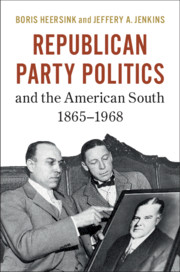Book contents
- Republican Party Politics and the American South, 1865–1968
- Republican Party Politics and the American South, 1865–1968
- Copyright page
- Contents
- Tables
- Figures
- Preface
- 1 Introduction
- 2 The Republican Party and the South: Some Preliminaries
- Part I The South and National Republican Party Politics, 1865–1968
- 3 The Rise and Fall of a Republican South, 1865–1877
- 4 The Attempt to Rebuild the Republican Party in the South, 1877–1896
- 5 The System of 1896 and Republicanism in the South, 1897–1932
- 6 Toward a Modern Southern Strategy, 1933–1968
- Photos
- Part II Southern Republican Party Politics at the State Level
- Index
3 - The Rise and Fall of a Republican South, 1865–1877
from Part I - The South and National Republican Party Politics, 1865–1968
Published online by Cambridge University Press: 06 March 2020
- Republican Party Politics and the American South, 1865–1968
- Republican Party Politics and the American South, 1865–1968
- Copyright page
- Contents
- Tables
- Figures
- Preface
- 1 Introduction
- 2 The Republican Party and the South: Some Preliminaries
- Part I The South and National Republican Party Politics, 1865–1968
- 3 The Rise and Fall of a Republican South, 1865–1877
- 4 The Attempt to Rebuild the Republican Party in the South, 1877–1896
- 5 The System of 1896 and Republicanism in the South, 1897–1932
- 6 Toward a Modern Southern Strategy, 1933–1968
- Photos
- Part II Southern Republican Party Politics at the State Level
- Index
Summary
The contours of Republican Party development in the South along with the legitimate successes that were achieved for black citizens and black civil rights more generally – before it all came crashing down – is the subject of this chapter. We focus first on the development of a Republican South after the Civil War. At first, Republican leaders were resistant to the creation of a Southern wing of the party, mainly because moderate members believed that enfranchising blacks – a necessary condition for the creation of a Southern GOP – was too radical for the Northern public to accept. They came around to the idea only reluctantly, after President Andrew Johnson broke with the Republicans on Reconstruction and the protection of black civil rights, and the Northern public sided with the GOP in the elections of 1866. Once invested in the notion of creating a Southern wing, Republican leaders stacked the deck by dividing the South into military districts, enfranchising blacks, and requiring new constitutions to be drafted before states would be readmitted to the Union. Combined, this led to some initial GOP electoral successes in the former Confederacy. These successes were not sustainable, however, despite strong and loyal black support, as a consistent and large proportion of white Southerners could not be persuaded to vote Republican. Without a true biracial foundation, the Southern wing of the GOP – confronted with violence and intimidation by white paramilitary groups working on behalf of the Democrats, as well as intra-party conflict – steadily collapsed, and Republican politicians were systematically driven from power. By 1877, white Southern Democrats had effectively “redeemed” all of the ex-Confederate states, and Reconstruction – despite its very real achievements, like the wealth of office-holding experience it provided for black citizens – had come to an end.
Keywords
- Type
- Chapter
- Information
- Republican Party Politics and the American South, 1865–1968 , pp. 66 - 100Publisher: Cambridge University PressPrint publication year: 2020

